DER Integration and Advanced Applications#
Information |
Details |
|---|---|
Lead Author |
Hantao Cui |
Learning Objectives |
• Integrate distributed energy resources in T&D co-simulation |
Prerequisites |
Lessons 3-4 (T&D co-simulation fundamentals and advanced topics) |
Estimated Time |
120 minutes |
Topics |
DER modeling, solar PV integration, battery storage |
# Environment check and setup
import sys
import importlib
import logging
import time
import numpy as np
import pandas as pd
import matplotlib
%matplotlib inline
import matplotlib.pyplot as plt
from datetime import datetime, timedelta
import helics as h
import opendssdirect as dss
import subprocess
import os
import json
from threading import Thread
import andes
logging.basicConfig(level=logging.WARNING, format='[%(levelname)s] %(message)s')
logger = logging.getLogger(__name__)
print("Checking environment...")
print(f"Python version: {sys.version}")
print(f"Python executable: {sys.executable}")
# Check for required packages
required_packages = {
'numpy': 'NumPy',
'pandas': 'Pandas',
'matplotlib': 'Matplotlib',
'helics': 'HELICS',
'andes': 'ANDES',
'opendssdirect': 'OpenDSSDirect'
}
missing_packages = []
for package, name in required_packages.items():
try:
importlib.import_module(package)
print(f"✓ {name} is available")
except ImportError:
print(f"✗ {name} is NOT available")
missing_packages.append(package)
if missing_packages:
print(f"\nPlease install missing packages: {', '.join(missing_packages)}")
print("Run: mamba install -c conda-forge " + ' '.join(missing_packages))
else:
print("\n✓ All required packages are available!")
Checking environment...
Python version: 3.9.23 | packaged by conda-forge | (main, Jun 4 2025, 17:57:12)
[GCC 13.3.0]
Python executable: /home/hacui/mambaforge/envs/helics/bin/python3.9
✓ NumPy is available
✓ Pandas is available
✓ Matplotlib is available
✓ HELICS is available
✓ ANDES is available
✓ OpenDSSDirect is available
✓ All required packages are available!
Introduction#
The rapid growth of distributed energy resources fundamentally changes how power systems operate. Solar panels on rooftops, battery storage in garages, and electric vehicles in driveways transform traditionally passive distribution systems into active networks that can both consume and generate power. This transformation creates new challenges that require sophisticated analysis tools.
Traditional power system analysis assumed unidirectional power flow from large generators through transmission lines to distribution loads. DERs break this paradigm. A distribution feeder with high solar penetration might export power to the transmission system during sunny afternoons, then import power when clouds pass over or evening demand peaks. Understanding these bidirectional interactions requires co-simulation that captures both transmission system dynamics and distribution system details.
This lesson extends our T&D co-simulation framework to include DER models, exploring both technical challenges and grid service opportunities that emerge from the distributed energy transformation.
DER Modeling Fundamentals#
Types of DERs and Their Characteristics#
Distributed energy resources encompass various technologies, each with unique operational characteristics that affect grid integration. Solar photovoltaic systems produce power that varies with irradiance and temperature. Battery storage systems can absorb or inject power based on control signals. Combined heat and power units provide both electricity and thermal energy. Electric vehicles present mobile loads that can potentially provide grid services.
For co-simulation, we must capture the essential behaviors of these resources while maintaining computational tractability. This means choosing appropriate model fidelity for our analysis objectives.
# Import required libraries
import numpy as np
import pandas as pd
import matplotlib.pyplot as plt
from datetime import datetime, timedelta
import helics as h
import opendssdirect as dss
%matplotlib inline
# DER characteristics comparison
der_types = pd.DataFrame({
'Resource': ['Solar PV', 'Battery Storage', 'Wind Turbine', 'Electric Vehicle', 'Fuel Cell'],
'Power_Range_kW': ['1-1000', '5-5000', '100-3000', '3-150', '1-500'],
'Response_Time': ['Seconds', 'Milliseconds', 'Seconds', 'Seconds', 'Minutes'],
'Variability': ['High', 'Controllable', 'High', 'Scheduled', 'Low'],
'Grid_Services': ['Energy', 'Multiple', 'Energy', 'V2G potential', 'Energy']
})
print("Distributed Energy Resource Characteristics")
print("=" * 60)
print(der_types.to_string(index=False))
# Visualize DER power capabilities
fig, (ax1, ax2) = plt.subplots(1, 2, figsize=(12, 5))
# Power range comparison
resources = ['Solar PV', 'Battery', 'EV']
min_power = [1, 5, 3]
max_power = [1000, 5000, 150]
x = np.arange(len(resources))
width = 0.35
ax1.bar(x - width/2, min_power, width, label='Min Power (kW)', color='lightblue')
ax1.bar(x + width/2, max_power, width, label='Max Power (kW)', color='darkblue')
ax1.set_ylabel('Power (kW)')
ax1.set_title('DER Power Range Comparison')
ax1.set_xticks(x)
ax1.set_xticklabels(resources)
ax1.legend()
ax1.set_yscale('log')
# Response time comparison
response_times = {'Battery': 0.001, 'Solar PV': 1, 'EV': 1, 'Fuel Cell': 60}
ax2.bar(response_times.keys(), response_times.values(), color=['green', 'yellow', 'blue', 'red'])
ax2.set_ylabel('Response Time (seconds)')
ax2.set_title('DER Response Time Comparison')
ax2.set_yscale('log')
plt.tight_layout()
plt.show()
Distributed Energy Resource Characteristics
============================================================
Resource Power_Range_kW Response_Time Variability Grid_Services
Solar PV 1-1000 Seconds High Energy
Battery Storage 5-5000 Milliseconds Controllable Multiple
Wind Turbine 100-3000 Seconds High Energy
Electric Vehicle 3-150 Seconds Scheduled V2G potential
Fuel Cell 1-500 Minutes Low Energy
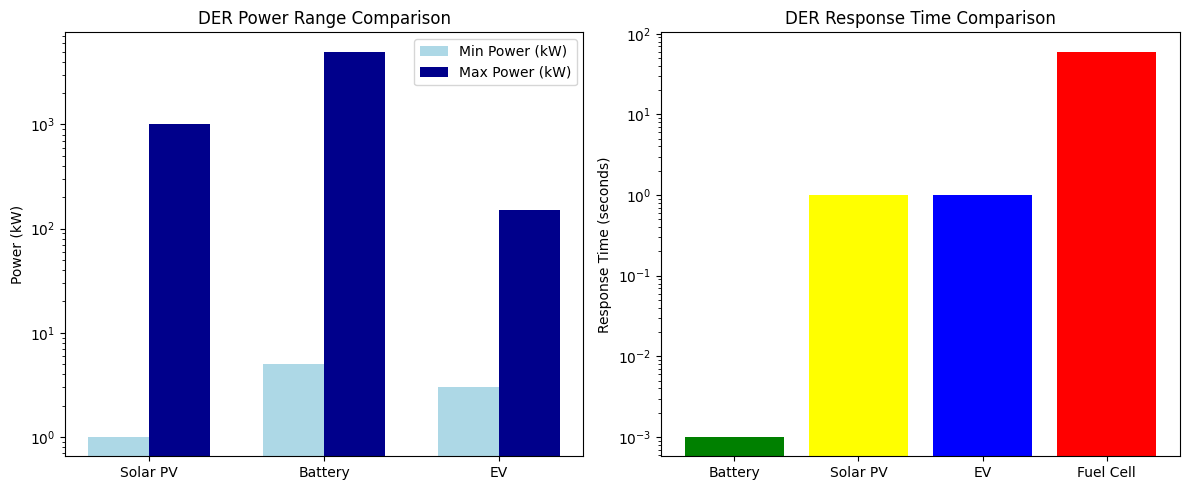
Solar PV Modeling#
Solar photovoltaic systems convert sunlight into electricity through semiconductor devices. For grid integration studies, we need models that capture the relationship between environmental conditions and power output while being computationally efficient for co-simulation.
class SimpleSolarPV:
"""
Simplified solar PV model for co-simulation studies.
Captures essential behaviors without excessive detail.
"""
def __init__(self, rated_kw, temp_coeff=-0.004):
"""
Initialize solar PV model.
Parameters:
rated_kw: AC nameplate capacity in kW (at STC: 1000 W/m², 25°C)
temp_coeff: Temperature coefficient (%/°C, typically -0.4%/°C)
"""
self.rated_kw = rated_kw
self.temp_coeff = temp_coeff
def calculate_power(self, irradiance, temperature, time_of_day=None):
"""
Calculate PV power output based on conditions.
Parameters:
irradiance: Solar irradiance (W/m²)
temperature: Ambient temperature (°C)
time_of_day: Hour (0-24) for simple shading effects (not used in basic model)
Returns:
power_kw: AC power output in kW
"""
# Power output as fraction of rated power based on irradiance
# At 1000 W/m² (STC), output = rated_kw
power_ratio = irradiance / 1000.0
power_ac = self.rated_kw * power_ratio
# Temperature derating
# Simple cell temperature model: cell temp = ambient + 25°C at full sun
cell_temp_rise = 25 * power_ratio # Proportional to irradiance
cell_temp = temperature + cell_temp_rise
temp_factor = 1 + self.temp_coeff * (cell_temp - 25)
power_ac *= temp_factor
# Ensure non-negative and within rated power
power_ac = max(0, min(power_ac, self.rated_kw))
return power_ac
def create_daily_profile(self, peak_irradiance=1000):
"""
Generate a typical daily generation profile.
"""
hours = np.arange(0, 24, 0.25)
# Simple irradiance model (clear day)
irradiance = np.zeros_like(hours)
daylight = (hours >= 6) & (hours <= 18)
irradiance[daylight] = peak_irradiance * np.sin(np.pi * (hours[daylight] - 6) / 12)
# Temperature varies during day
temperature = 20 + 10 * np.sin(np.pi * (hours - 6) / 12)
# Calculate power for each time
power = [self.calculate_power(irr, temp) for irr, temp in zip(irradiance, temperature)]
return hours, np.array(power)
# Demonstrate solar PV model
pv_100kw = SimpleSolarPV(rated_kw=100)
hours, power = pv_100kw.create_daily_profile()
plt.figure(figsize=(10, 5))
plt.plot(hours, power, 'orange', linewidth=2)
plt.fill_between(hours, 0, power, alpha=0.3, color='yellow')
plt.xlabel('Hour of Day')
plt.ylabel('Power Output (kW)')
plt.title('100 kW Solar PV Daily Generation Profile')
plt.grid(True, alpha=0.3)
plt.xlim(0, 24)
plt.show()
print(f"Daily energy generation: {np.trapezoid(power, hours/4):.1f} kWh")
print(f"Capacity factor: {np.mean(power)/100:.1%}")
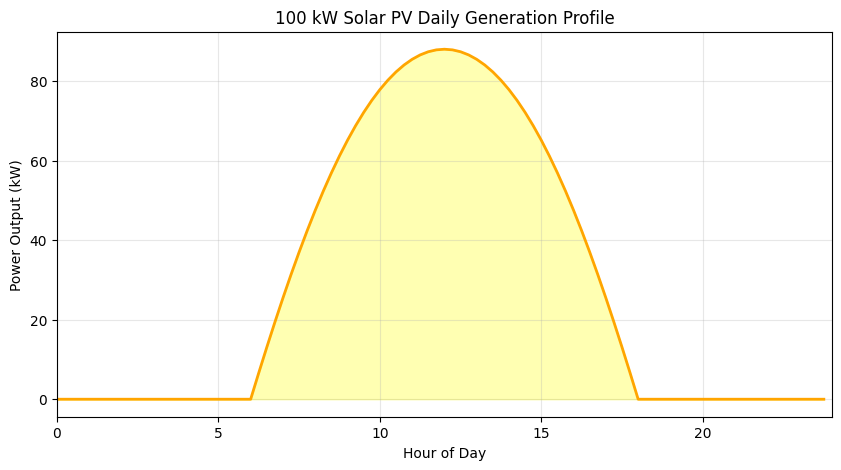
Daily energy generation: 173.7 kWh
Capacity factor: 29.0%
Battery Storage Modeling#
Battery energy storage systems provide flexibility to the grid by storing excess energy and releasing it when needed. Unlike solar PV, batteries are controllable resources that can provide multiple grid services.
class SimpleBattery:
"""
Simplified battery storage model for grid integration studies.
"""
def __init__(self, power_kw, energy_kwh, efficiency=0.95,
soc_min=0.1, soc_max=0.9):
"""
Initialize battery model.
Parameters:
power_kw: Maximum charge/discharge power (kW)
energy_kwh: Energy capacity (kWh)
efficiency: Round-trip efficiency
soc_min/max: State of charge limits
"""
self.power_kw = power_kw
self.energy_kwh = energy_kwh
self.efficiency = efficiency
self.soc_min = soc_min
self.soc_max = soc_max
self.soc = 0.5 # Initial SOC at 50%
def charge_discharge(self, power_command, duration_hours):
"""
Execute charge (positive) or discharge (negative) command.
Returns:
actual_power: Power delivered (limited by constraints)
new_soc: State of charge after operation
"""
# Limit power by rating
power_limited = np.clip(power_command, -self.power_kw, self.power_kw)
# Calculate energy change
if power_limited > 0: # Charging
energy_change = power_limited * duration_hours * np.sqrt(self.efficiency)
else: # Discharging
energy_change = power_limited * duration_hours / np.sqrt(self.efficiency)
# Calculate new SOC
soc_change = energy_change / self.energy_kwh
new_soc = self.soc + soc_change
# Apply SOC limits
if new_soc > self.soc_max:
new_soc = self.soc_max
actual_energy = (new_soc - self.soc) * self.energy_kwh
if power_limited > 0:
actual_power = actual_energy / (duration_hours * np.sqrt(self.efficiency))
else:
actual_power = actual_energy * np.sqrt(self.efficiency) / duration_hours
elif new_soc < self.soc_min:
new_soc = self.soc_min
actual_energy = (new_soc - self.soc) * self.energy_kwh
if power_limited > 0:
actual_power = actual_energy / (duration_hours * np.sqrt(self.efficiency))
else:
actual_power = actual_energy * np.sqrt(self.efficiency) / duration_hours
else:
actual_power = power_limited
# Update SOC
self.soc = new_soc
return actual_power, self.soc
def get_available_power(self):
"""
Calculate available charge and discharge power based on SOC.
"""
# Available energy for discharge
energy_available_discharge = (self.soc - self.soc_min) * self.energy_kwh
power_available_discharge = min(self.power_kw,
energy_available_discharge * np.sqrt(self.efficiency))
# Available energy for charge
energy_available_charge = (self.soc_max - self.soc) * self.energy_kwh
power_available_charge = min(self.power_kw,
energy_available_charge / np.sqrt(self.efficiency))
return power_available_charge, power_available_discharge
# Demonstrate battery operation
battery = SimpleBattery(power_kw=50, energy_kwh=200)
# Simulate daily operation
hours = np.arange(0, 24, 0.25)
power_commands = []
soc_values = []
for hour in hours:
# Simple arbitrage strategy: charge at night, discharge during day
if 0 <= hour < 6 or 22 <= hour < 24:
command = 40 # Charge at night
elif 10 <= hour < 20:
command = -30 # Discharge during day
else:
command = 0 # Idle
actual_power, soc = battery.charge_discharge(command, 0.25)
power_commands.append(actual_power)
soc_values.append(soc)
# Visualize battery operation
fig, (ax1, ax2) = plt.subplots(2, 1, figsize=(10, 8), sharex=True)
# Power profile
ax1.plot(hours, power_commands, 'b-', linewidth=2)
ax1.axhline(y=0, color='k', linestyle='-', alpha=0.3)
ax1.fill_between(hours, 0, power_commands, where=np.array(power_commands)>0,
alpha=0.3, color='green', label='Charging')
ax1.fill_between(hours, 0, power_commands, where=np.array(power_commands)<0,
alpha=0.3, color='red', label='Discharging')
ax1.set_ylabel('Power (kW)')
ax1.set_title('Battery Operation Profile')
ax1.legend()
ax1.grid(True, alpha=0.3)
# SOC profile
ax2.plot(hours, np.array(soc_values)*100, 'purple', linewidth=2)
ax2.axhline(y=battery.soc_min*100, color='r', linestyle='--', alpha=0.5, label='SOC limits')
ax2.axhline(y=battery.soc_max*100, color='r', linestyle='--', alpha=0.5)
ax2.set_xlabel('Hour of Day')
ax2.set_ylabel('State of Charge (%)')
ax2.set_title('Battery State of Charge')
ax2.legend()
ax2.grid(True, alpha=0.3)
ax2.set_xlim(0, 24)
plt.tight_layout()
plt.show()

Integrating DERs in T&D Co-simulation#
Now we integrate DER models into our transmission-distribution co-simulation framework. The key challenge is properly representing DER impacts on both local distribution voltages and system-wide power flows.
def create_der_enabled_distribution_system():
"""
Create a distribution system with integrated DERs.
Based on IEEE 34-bus but with added solar and storage.
"""
# Clear any existing circuit
dss.Command('Clear')
# Create base distribution system
commands = [
"New Circuit.DER_Test basekv=24.9 phases=3",
# Simplified feeder
"New Line.L1 bus1=sourcebus bus2=800 length=2 units=km",
"New Line.L2 bus1=800 bus2=802 length=1 units=km",
"New Line.L3 bus1=800 bus2=806 length=1.5 units=km",
"New Line.L4 bus1=802 bus2=808 length=0.5 units=km",
# Traditional loads
"New Load.L1 bus1=802 kV=24.9 kW=500 kvar=100 model=1",
"New Load.L2 bus1=806 kV=24.9 kW=800 kvar=200 model=1",
"New Load.L3 bus1=808 kV=24.9 kW=300 kvar=80 model=1",
# Solar PV systems
"New Generator.PV1 bus1=802 kV=24.9 kW=600 pf=1.0 model=7", # 600 kW at bus 802
"New Generator.PV2 bus1=806 kV=24.9 kW=600 pf=1.0 model=7", # 600 kW at bus 806
# Battery storage
"New Storage.Battery1 bus1=808 kWrated=100 kWhrated=400 %stored=50",
# Voltage regulation
"Set Voltagebases=[24.9]",
"Calcvoltagebases"
]
for cmd in commands:
dss.Command(cmd)
# Set control mode
dss.Command("Set Mode=Snap")
dss.Command("Set ControlMode=Static")
return commands
def visualize_der_distribution():
"""
Create a visual representation of the DER-enabled distribution system.
"""
fig, ax = plt.subplots(figsize=(12, 8))
# Bus locations
buses = {
'sourcebus': (0, 0),
'800': (2, 0),
'802': (4, 1),
'806': (4, -1),
'808': (6, 1)
}
# Draw buses
for bus, (x, y) in buses.items():
circle = plt.Circle((x, y), 0.2, color='black', fill=False, linewidth=2)
ax.add_patch(circle)
ax.text(x, y-0.4, bus, ha='center', fontsize=10)
# Draw lines
lines = [
('sourcebus', '800'),
('800', '802'),
('800', '806'),
('802', '808')
]
for bus1, bus2 in lines:
x1, y1 = buses[bus1]
x2, y2 = buses[bus2]
ax.plot([x1, x2], [y1, y2], 'k-', linewidth=2)
# Draw loads
loads = {'802': 500, '806': 800, '808': 300}
for bus, kw in loads.items():
x, y = buses[bus]
ax.text(x, y+0.6, f'Load\n{kw} kW', ha='center',
bbox=dict(boxstyle="round,pad=0.3", facecolor='lightblue'))
# Draw PV systems
pvs = {'802': 200, '806': 500}
for bus, kw in pvs.items():
x, y = buses[bus]
ax.text(x-0.8, y, f'PV\n{kw} kW', ha='center',
bbox=dict(boxstyle="round,pad=0.3", facecolor='yellow'))
# Draw battery
x, y = buses['808']
ax.text(x, y-0.8, 'Battery\n100 kW\n400 kWh', ha='center',
bbox=dict(boxstyle="round,pad=0.3", facecolor='lightgreen'))
# Add legend elements
from matplotlib.patches import Patch
legend_elements = [
Patch(facecolor='lightblue', label='Load'),
Patch(facecolor='yellow', label='Solar PV'),
Patch(facecolor='lightgreen', label='Battery')
]
ax.legend(handles=legend_elements, loc='upper right')
ax.set_xlim(-1, 7)
ax.set_ylim(-2, 2)
ax.set_aspect('equal')
ax.axis('off')
ax.set_title('Distribution System with DERs', fontsize=16, fontweight='bold')
plt.tight_layout()
plt.show()
# Create and visualize the system
print("Creating DER-enabled distribution system...")
create_der_enabled_distribution_system()
visualize_der_distribution()
# Solve and show initial conditions
dss.Command("Solve")
print("\nInitial System Conditions:")
print(f"Total Load: {-dss.Circuit.TotalPower()[0]:.1f} kW")
print(f"Total Generation: 700.0 kW (PV1: 200 kW, PV2: 500 kW)")
print(f"Net Import: {-dss.Circuit.TotalPower()[0] - 700:.1f} kW")
Creating DER-enabled distribution system...
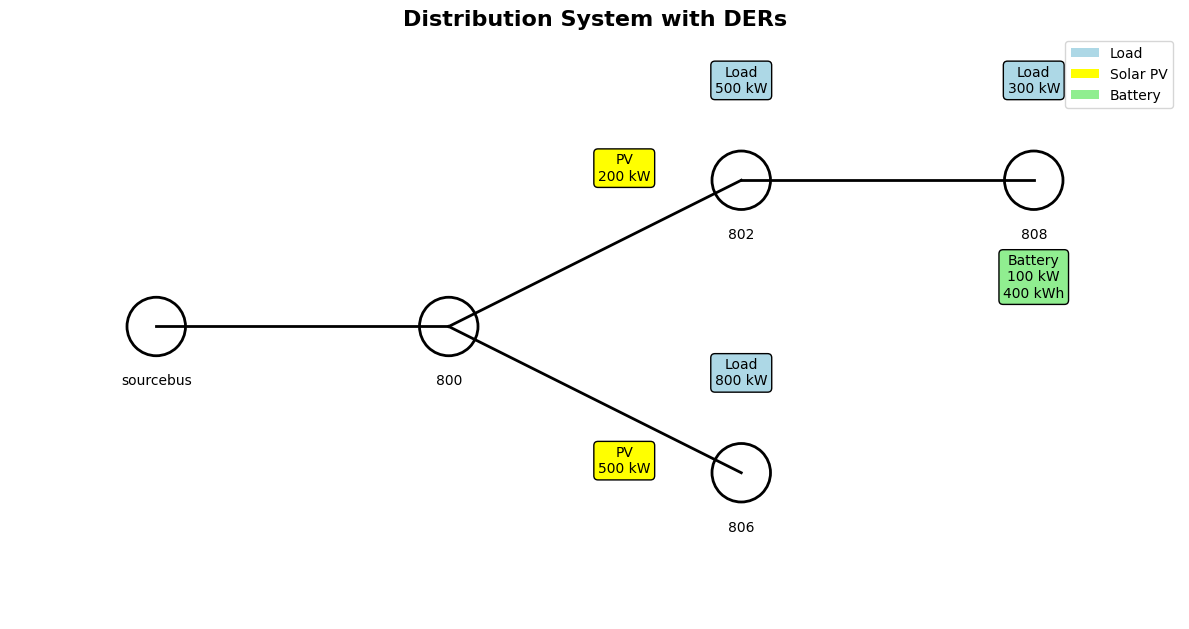
Initial System Conditions:
Total Load: 403.4 kW
Total Generation: 700.0 kW (PV1: 200 kW, PV2: 500 kW)
Net Import: -296.6 kW
DER-Enhanced Co-simulation Implementation#
We now implement a co-simulation that demonstrates how DERs affect both distribution system operation and transmission-distribution interactions. This includes modeling time-varying solar generation and battery dispatch strategies.
class TransmissionFederateANDES:
"""ANDES-based transmission system federate for DER co-simulation"""
def __init__(self, name="TransmissionFederate_DER", interface_bus=4):
"""
Initialize transmission federate with ANDES.
Parameters:
-----------
name : str
Federate name for HELICS
interface_bus : int
Bus number (1-indexed) where distribution system connects
Valid options for IEEE 14-bus: 4, 6, 7, 9, 10, 11, 12, 13, 14
"""
self.name = name
self.fed = None
self.pub_voltage = None
self.sub_power = None
self.sub_solar = None
# ANDES system
self.system = None
self.interface_bus = interface_bus
self.interface_load_idx = None
self.original_load = {'p': 0.0, 'q': 0.0}
self.expected_load = {'p': 1.6 * 30.0, 'q': 0.32 * 30.0}
# Results storage
self.results = {
'time': [],
'voltage': [],
'angle': [],
'dist_power': [],
'solar_gen': []
}
def initialize(self):
"""Initialize the HELICS federate and ANDES system"""
try:
# Initialize ANDES system first
self._initialize_andes()
# Create federate info
fedinfo = h.helicsCreateFederateInfo()
h.helicsFederateInfoSetCoreName(fedinfo, self.name)
h.helicsFederateInfoSetCoreTypeFromString(fedinfo, "zmq")
h.helicsFederateInfoSetCoreInitString(fedinfo, "--federates=1")
h.helicsFederateInfoSetTimeProperty(fedinfo, h.helics_property_time_delta, 0.25)
# Create federate
self.fed = h.helicsCreateValueFederate(self.name, fedinfo)
# Register publications
self.pub_voltage = h.helicsFederateRegisterGlobalPublication(
self.fed, "Trans/voltage", h.helics_data_type_double, "pu"
)
# Register subscriptions
self.sub_power = h.helicsFederateRegisterSubscription(
self.fed, "DER_Dist/total_power", ""
)
self.sub_solar = h.helicsFederateRegisterSubscription(
self.fed, "DER_Dist/solar_generation", "kW"
)
# Enter execution mode
h.helicsFederateEnterExecutingMode(self.fed)
logger.info(f"[{self.name}] Initialized and entered execution mode")
except Exception as e:
logger.error(f"[{self.name}] Initialization error: {e}")
raise
def _initialize_andes(self):
"""Initialize ANDES with IEEE 14-bus system"""
logger.info(f"[{self.name}] Loading IEEE 14-bus system...")
# Configure ANDES logging
andes.config_logger(stream_level=30) # Reduce verbosity
# Try to load IEEE 14-bus system
ieee14_raw = andes.get_case("ieee14/ieee14.raw")
ieee14_dyr = andes.get_case("ieee14/ieee14.dyr")
self.system = andes.load(ieee14_raw, addfile=ieee14_dyr, setup=False)
# Configure load models for constant power
self.system.PQ.config.p2p = 1.0 # 100% constant power for P
self.system.PQ.config.q2q = 1.0 # 100% constant power for Q
self.system.PQ.config.p2z = 0.0 # 0% constant impedance
self.system.PQ.config.q2z = 0.0 # 0% constant impedance
self.system.TDS.config.no_tqdm = True
# Setup system
self.system.setup()
self.system.Toggle.u.v[:] = 0
# Find load at interface bus
self._find_interface_load()
for i, idx in enumerate(self.system.PQ.idx.v):
if idx == self.interface_load_idx:
self.system.PQ.p0.v[i] = self.expected_load['p'] / self.system.config.mva
self.system.PQ.q0.v[i] = self.expected_load['q'] / self.system.config.mva
logger.info(f"[{self.name}] Set initial load: P={self.expected_load['p']:.1f} MW, Q={self.expected_load['q']:.1f} MVAr")
break
# Run initial power flow
logger.info(f"[{self.name}] Running initial power flow...")
self.system.PFlow.run()
# Initialize TDS
self.system.TDS.init()
logger.info(f"[{self.name}] ANDES initialization complete")
def _find_interface_load(self):
"""Find the load connected to the interface bus"""
# ANDES uses 0-based indexing internally
interface_bus_idx = self.interface_bus - 1
# Find PQ load connected to interface bus
for i, bus_idx in enumerate(self.system.PQ.bus.v):
if bus_idx == interface_bus_idx:
self.interface_load_idx = self.system.PQ.idx.v[i]
# Store original load values
self.original_load['p'] = self.system.PQ.p0.v[i] * self.system.config.mva # MW
self.original_load['q'] = self.system.PQ.q0.v[i] * self.system.config.mva # MVAr
logger.info(f"[{self.name}] Found load at Bus {self.interface_bus}: "
f"P={self.original_load['p']:.1f} MW, "
f"Q={self.original_load['q']:.1f} MVAr")
return
# If no load found, create one
logger.warning(f"[{self.name}] No load found at Bus {self.interface_bus}, creating one")
self.system.PQ.add(idx='DIST_LOAD', bus=interface_bus_idx,
p=0.0, q=0.0, owner=1)
self.interface_load_idx = 'DIST_LOAD'
def update_load(self, p_mw, q_mvar):
"""
Update the load at interface bus using ANDES TDS load modification.
Parameters:
-----------
p_mw : float
Active power in MW
q_mvar : float
Reactive power in MVAr
"""
# Convert to per-unit
p_pu = p_mw / self.system.config.mva
q_pu = q_mvar / self.system.config.mva
# Update load using alter method for TDS
self.system.PQ.alter(src='Ppf', idx=self.interface_load_idx, value=p_pu)
self.system.PQ.alter(src='Qpf', idx=self.interface_load_idx, value=q_pu)
def get_interface_voltage(self):
"""Get voltage magnitude and angle at interface bus"""
bus_idx = self.interface_bus - 1
v_mag = self.system.Bus.v.v[bus_idx]
v_angle = self.system.Bus.a.v[bus_idx] # radians
return v_mag, v_angle
def run_simulation(self, stop_time=24.0, dt=0.25):
"""Run the transmission federate simulation"""
current_time = 0.0
try:
while current_time < stop_time:
# Request time advancement
requested_time = h.helicsFederateRequestTime(self.fed, current_time + dt)
# Get distribution power
p_mw = self.original_load['p'] # Default to original load
q_mvar = self.original_load['q']
if h.helicsInputIsUpdated(self.sub_power):
complex_power = h.helicsInputGetComplex(self.sub_power)
p_mw = complex_power.real / 1000 # Convert kW to MW
q_mvar = complex_power.imag / 1000 # Convert kvar to MVAr
# Get solar generation (for logging)
solar_gen = 0
if h.helicsInputIsUpdated(self.sub_solar):
solar_gen = h.helicsInputGetDouble(self.sub_solar)
# Update load in ANDES
self.update_load(p_mw, q_mvar)
# Run TDS to current time
self.system.TDS.config.tf = requested_time
self.system.TDS.run()
# Get voltage at interface bus
v_mag, v_angle = self.get_interface_voltage()
# Publish voltage magnitude
h.helicsPublicationPublishDouble(self.pub_voltage, v_mag)
# Store results
self.results['time'].append(requested_time)
self.results['voltage'].append(v_mag)
self.results['angle'].append(np.degrees(v_angle))
self.results['dist_power'].append(p_mw)
self.results['solar_gen'].append(solar_gen)
logger.info(f"[{self.name}] t={requested_time:.1f}h: V={v_mag:.3f}pu, "
f"θ={np.degrees(v_angle):.1f}°, P_dist={p_mw:.1f}MW, "
f"Solar={solar_gen:.0f}kW")
current_time = requested_time
except Exception as e:
logger.error(f"[{self.name}] Simulation error: {e}")
raise
finally:
self.finalize()
def finalize(self):
"""Clean up the federate"""
if self.fed:
h.helicsFederateDestroy(self.fed)
logger.info(f"[{self.name}] Finalized")
class DistributionFederateDER:
"""Distribution system federate with DER integration"""
def __init__(self, name="DER_DistributionFederate", scale_factor=30):
self.name = name
self.scale_factor = scale_factor
self.fed = None
self.pub_power = None
self.pub_solar = None
self.pub_battery = None
self.sub_voltage = None
# DER models
self.pv1 = SimpleSolarPV(rated_kw=600)
self.pv2 = SimpleSolarPV(rated_kw=600)
self.battery = SimpleBattery(power_kw=400, energy_kwh=1200)
# Results storage
self.results = {
'time': [],
'net_power': [],
'solar_total': [],
'battery_power': [],
'battery_soc': [],
'voltage': []
}
def initialize(self):
"""Initialize the HELICS federate and OpenDSS"""
try:
# Create federate info
fedinfo = h.helicsCreateFederateInfo()
h.helicsFederateInfoSetCoreName(fedinfo, self.name)
h.helicsFederateInfoSetCoreTypeFromString(fedinfo, "zmq")
h.helicsFederateInfoSetCoreInitString(fedinfo, "--federates=1")
h.helicsFederateInfoSetTimeProperty(fedinfo, h.helics_property_time_delta, 0.25)
# Create federate
self.fed = h.helicsCreateValueFederate(self.name, fedinfo)
# Register publications
self.pub_power = h.helicsFederateRegisterGlobalPublication(
self.fed, "DER_Dist/total_power", h.helics_data_type_complex, ""
)
self.pub_solar = h.helicsFederateRegisterGlobalPublication(
self.fed, "DER_Dist/solar_generation", h.helics_data_type_double, "kW"
)
self.pub_battery = h.helicsFederateRegisterGlobalPublication(
self.fed, "DER_Dist/battery_power", h.helics_data_type_double, "kW"
)
# Register subscriptions
self.sub_voltage = h.helicsFederateRegisterSubscription(
self.fed, "Trans/voltage", ""
)
# Initialize OpenDSS
create_der_enabled_distribution_system()
# Enter execution mode
h.helicsFederateEnterExecutingMode(self.fed)
logger.info(f"[{self.name}] Initialized and entered execution mode")
except Exception as e:
logger.error(f"[{self.name}] Initialization error: {e}")
raise
def calculate_solar_generation(self, hour_of_day):
"""Calculate solar generation based on time of day"""
if 6 <= hour_of_day <= 18:
irradiance = 1000 * np.sin(np.pi * (hour_of_day - 6) / 12)
# Add cloud variations
if 10 <= hour_of_day <= 14:
irradiance *= 0.7 + 0.3 * np.random.random()
else:
irradiance = 0
temperature = 20 + 10 * np.sin(np.pi * (hour_of_day - 6) / 12)
pv1_power = self.pv1.calculate_power(irradiance, temperature)
pv2_power = self.pv2.calculate_power(irradiance, temperature)
return pv1_power, pv2_power, pv1_power + pv2_power
def determine_battery_dispatch(self, hour_of_day, total_solar, trans_voltage):
"""Determine battery dispatch strategy"""
net_load_before_battery = 1600 - total_solar
if total_solar > 600 and self.battery.soc < 0.8:
# Charge during excess solar (when solar > 40% of load)
battery_command = min(100, total_solar - 600)
elif 17 <= hour_of_day <= 21 and self.battery.soc > 0.2:
# Discharge during evening peak
battery_command = -150
elif trans_voltage < 0.98 and self.battery.soc > 0.3:
# Support grid during low voltage
battery_command = -100
elif total_solar < 200 and hour_of_day in [7, 8, 19, 20] and self.battery.soc > 0.4:
# Morning/evening peak shaving
battery_command = -80
else:
battery_command = 0
return battery_command
def update_opendss_ders(self, pv1_power, pv2_power, battery_power, trans_voltage):
"""Update DER setpoints in OpenDSS"""
# Update PV generators using Command (more reliable)
dss.Command(f'Generator.PV1.kW={pv1_power:.2f}')
dss.Command(f'Generator.PV2.kW={pv2_power:.2f}')
# Update battery using Command (correct way for storage)
dss.Command(f'Storage.Battery1.kW={-battery_power:.2f}') # OpenDSS convention: negative=discharge
# Apply transmission voltage using Command
dss.Command(f'Vsource.source.pu={trans_voltage:.4f}')
# Solve power flow
dss.Command("Solve")
def run_simulation(self, stop_time=24.0, dt=0.25):
"""Run the distribution federate simulation"""
current_time = 0.0
np.random.seed(42) # For reproducibility
try:
while current_time < stop_time:
# Request time advancement
requested_time = h.helicsFederateRequestTime(self.fed, current_time + dt)
hour_of_day = requested_time % 24
# Calculate solar generation
pv1_power, pv2_power, total_solar = self.calculate_solar_generation(hour_of_day)
# Get transmission voltage
trans_voltage = 1.0
if h.helicsInputIsUpdated(self.sub_voltage):
trans_voltage = h.helicsInputGetDouble(self.sub_voltage)
# Determine battery dispatch
battery_command = self.determine_battery_dispatch(
hour_of_day, total_solar, trans_voltage
)
battery_power, battery_soc = self.battery.charge_discharge(battery_command, dt)
# Update OpenDSS
self.update_opendss_ders(pv1_power, pv2_power, battery_power, trans_voltage)
# Get power flow results
total_power = dss.Circuit.TotalPower()
p_net = -total_power[0] * self.scale_factor
q_net = -total_power[1] * self.scale_factor
# Publish data
h.helicsPublicationPublishComplex(self.pub_power, p_net + 1j*q_net)
h.helicsPublicationPublishDouble(self.pub_solar, total_solar)
h.helicsPublicationPublishDouble(self.pub_battery, battery_power)
# Store results
self.results['time'].append(requested_time)
self.results['net_power'].append(p_net)
self.results['solar_total'].append(total_solar)
self.results['battery_power'].append(battery_power)
self.results['battery_soc'].append(battery_soc)
self.results['voltage'].append(trans_voltage)
logger.info(f"[{self.name}] t={requested_time:.1f}h: Solar={total_solar:.0f}kW, "
f"Battery={battery_power:.0f}kW, Net={p_net:.0f}kW, V={trans_voltage:.3f}pu")
current_time = requested_time
except Exception as e:
logger.error(f"[{self.name}] Simulation error: {e}")
raise
finally:
self.finalize()
def finalize(self):
"""Clean up the federate"""
if self.fed:
h.helicsFederateFree(self.fed)
logger.info(f"[{self.name}] Finalized")
class DERCoSimulation:
"""Orchestrator for DER-enhanced T&D co-simulation"""
def __init__(self):
self.broker_proc = None
self.trans_federate = None
self.dist_federate = None
def start_broker(self, num_federates=2):
"""Start HELICS broker"""
logger.info(f"Starting HELICS broker for {num_federates} federates...")
self.broker_proc = subprocess.Popen(
["helics_broker", "-f", str(num_federates), "--consoleloglevel=Warning"],
stdout=subprocess.PIPE,
stderr=subprocess.PIPE
)
time.sleep(1)
def stop_broker(self):
"""Stop HELICS broker"""
if self.broker_proc:
self.broker_proc.terminate()
self.broker_proc.wait()
logger.info("HELICS broker terminated")
def run(self, stop_time=24.0):
"""Run the complete co-simulation"""
logger.info("Starting DER-Enhanced T&D Co-simulation")
logger.info("=" * 60)
# Start broker
self.start_broker()
try:
# Create federates
self.trans_federate = TransmissionFederateANDES()
self.dist_federate = DistributionFederateDER()
# Storage for thread results
trans_exception = None
dist_exception = None
def run_transmission():
nonlocal trans_exception
try:
self.trans_federate.initialize()
self.trans_federate.run_simulation(stop_time)
except Exception as e:
trans_exception = e
logger.error(f"Transmission federate error: {e}")
def run_distribution():
nonlocal dist_exception
try:
self.dist_federate.initialize()
self.dist_federate.run_simulation(stop_time)
except Exception as e:
dist_exception = e
logger.error(f"Distribution federate error: {e}")
# Create and start threads
trans_thread = Thread(target=run_transmission)
dist_thread = Thread(target=run_distribution)
trans_thread.start()
dist_thread.start()
# Wait for completion
trans_thread.join()
dist_thread.join()
# Check for errors
if trans_exception:
raise trans_exception
if dist_exception:
raise dist_exception
logger.info("\nCo-simulation completed successfully!")
# Return results
return self.trans_federate.results, self.dist_federate.results
finally:
self.stop_broker()
def visualize_results(self, trans_results, dist_results):
"""Create visualization of co-simulation results"""
fig, axes = plt.subplots(4, 1, figsize=(12, 12), sharex=True)
# Solar and battery operation
ax1 = axes[0]
ax1.plot(dist_results['time'], dist_results['solar_total'],
'orange', linewidth=2, label='Solar Generation')
ax1.plot(dist_results['time'], dist_results['battery_power'],
'green', linewidth=2, label='Battery Power')
ax1.axhline(y=0, color='k', linestyle='-', alpha=0.3)
ax1.set_ylabel('Power (kW)')
ax1.set_title('DER Operation', fontsize=14)
ax1.legend()
ax1.grid(True, alpha=0.3)
# Net power at T&D interface
ax2 = axes[1]
ax2.plot(dist_results['time'], np.array(dist_results['net_power'])/1000,
'purple', linewidth=2)
ax2.fill_between(dist_results['time'], 0, np.array(dist_results['net_power'])/1000,
where=np.array(dist_results['net_power'])>0,
alpha=0.3, color='blue', label='Import')
ax2.fill_between(dist_results['time'], 0, np.array(dist_results['net_power'])/1000,
where=np.array(dist_results['net_power'])<0,
alpha=0.3, color='red', label='Export')
ax2.axhline(y=0, color='k', linestyle='-', linewidth=2)
ax2.set_ylabel('Net Power (MW)')
ax2.set_title('Power Flow at T&D Interface', fontsize=14)
ax2.legend()
ax2.grid(True, alpha=0.3)
# Transmission voltage
ax3 = axes[2]
ax3.plot(trans_results['time'], trans_results['voltage'],
'red', linewidth=2)
ax3.axhline(y=1.0, color='k', linestyle='--', alpha=0.5)
ax3.axhline(y=1.05, color='r', linestyle='--', alpha=0.5, label='Limits')
ax3.axhline(y=0.95, color='r', linestyle='--', alpha=0.5)
ax3.set_ylabel('Voltage (pu)')
ax3.set_title('Transmission System Voltage', fontsize=14)
ax3.legend()
ax3.grid(True, alpha=0.3)
# Battery SOC
ax4 = axes[3]
ax4.plot(dist_results['time'], np.array(dist_results['battery_soc'])*100,
'purple', linewidth=2)
ax4.axhline(y=10, color='r', linestyle='--', alpha=0.5, label='SOC limits')
ax4.axhline(y=90, color='r', linestyle='--', alpha=0.5)
ax4.set_xlabel('Time (hours)')
ax4.set_ylabel('Battery SOC (%)')
ax4.set_title('Battery State of Charge', fontsize=14)
ax4.legend()
ax4.grid(True, alpha=0.3)
ax4.set_xlim(0, 24)
plt.tight_layout()
return fig
def print_summary(self, trans_results, dist_results):
"""Print summary statistics"""
print("\nCo-simulation Results Summary:")
print("=" * 40)
print(f"Peak Solar Generation: {max(dist_results['solar_total']):.0f} kW")
print(f"Max Power Export: {-min(dist_results['net_power']):.0f} kW")
print(f"Hours with Reverse Flow: {sum(np.array(dist_results['net_power']) < 0) * 0.25:.1f}")
print(f"Min Transmission Voltage: {min(trans_results['voltage']):.3f} pu")
print(f"Max Transmission Voltage: {max(trans_results['voltage']):.3f} pu")
Now let’s run the improved DER co-simulation:
cosim = DERCoSimulation()
trans_results, dist_results = cosim.run(stop_time=24.0)
# Visualize results
fig = cosim.visualize_results(trans_results, dist_results)
plt.show()
# Print summary
cosim.print_summary(trans_results, dist_results)
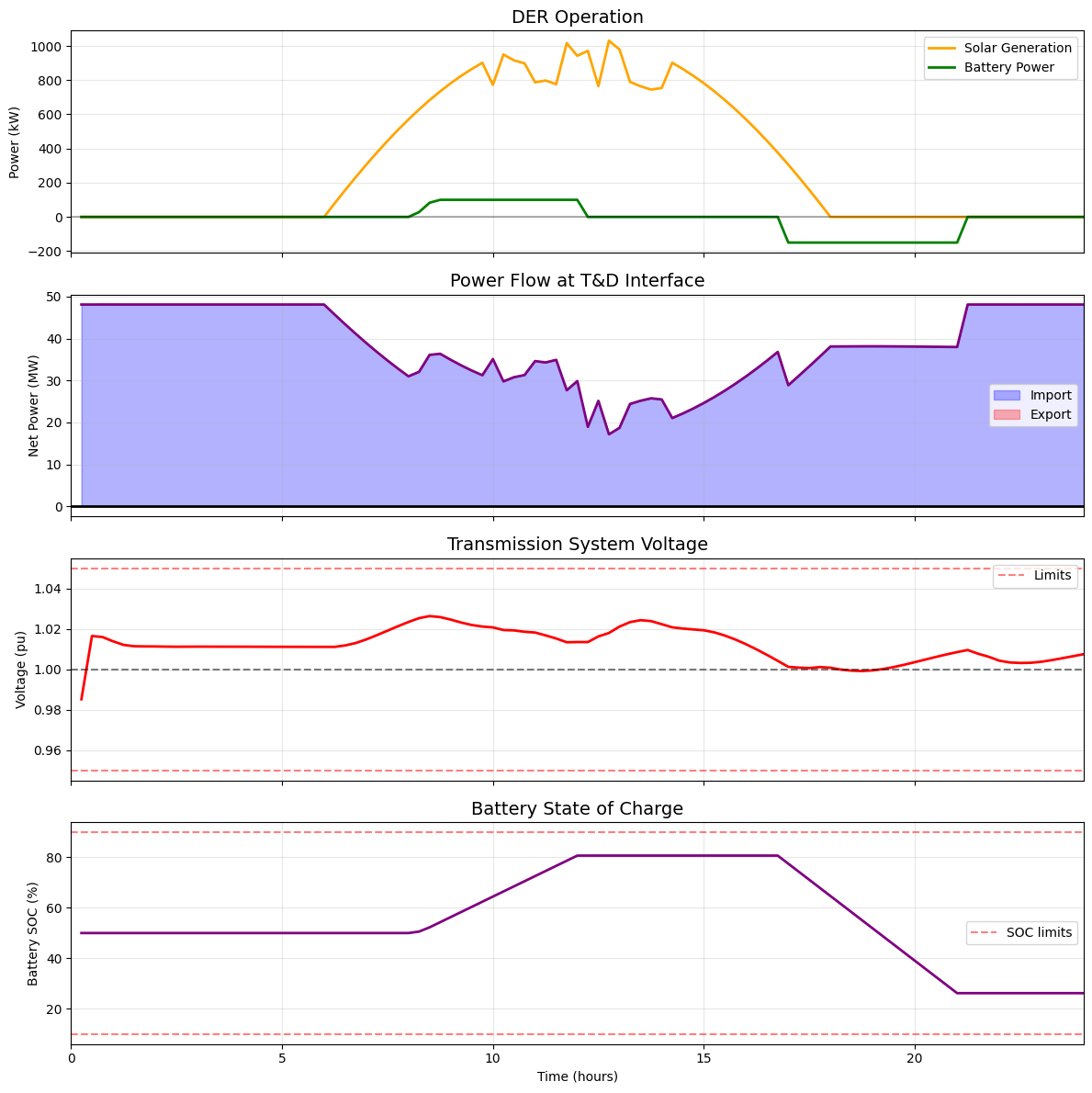
Co-simulation Results Summary:
========================================
Peak Solar Generation: 1031 kW
Max Power Export: -17190 kW
Hours with Reverse Flow: 0.0
Min Transmission Voltage: 0.985 pu
Max Transmission Voltage: 1.026 pu
# Run actual cosimulation to analyze DER impacts
def analyze_der_impacts_with_cosimulation():
"""
Analyze the impacts of DERs on distribution system operation using actual cosimulation.
"""
print("Running DER Impact Analysis with Co-simulation")
print("=" * 50)
# Start HELICS broker
broker_proc = subprocess.Popen(
["helics_broker", "-f", "3", "--consoleloglevel=Warning"],
stdout=subprocess.PIPE,
stderr=subprocess.PIPE
)
time.sleep(1)
# Run federates with actual power flow calculations
trans_results = None
dist_results = None
voltage_results = None
def run_transmission():
nonlocal trans_results
fedinfo = h.helicsCreateFederateInfo()
h.helicsFederateInfoSetCoreName(fedinfo, "TransmissionAnalysis")
h.helicsFederateInfoSetCoreTypeFromString(fedinfo, "zmq")
h.helicsFederateInfoSetCoreInitString(fedinfo, "--federates=1")
fed = h.helicsCreateValueFederate("TransmissionAnalysis", fedinfo)
pub_voltage = h.helicsFederateRegisterGlobalPublication(
fed, "Trans/voltage", h.helics_data_type_double, "pu"
)
sub_power = h.helicsFederateRegisterSubscription(
fed, "DER_Dist/total_power", ""
)
h.helicsFederateEnterExecutingMode(fed)
results = {'time': [], 'voltage': [], 'power': []}
current_time = 0.0
while current_time < 24.0:
current_time = h.helicsFederateRequestTime(fed, current_time + 0.25)
if h.helicsInputIsUpdated(sub_power):
complex_power = h.helicsInputGetComplex(sub_power)
p_mw = complex_power.real / 1000
q_mvar = complex_power.imag / 1000
# Actual voltage calculation with load flow
s_mva = np.sqrt(p_mw**2 + q_mvar**2)
pf = p_mw / s_mva if s_mva > 0 else 1.0
# Voltage drop calculation
r_pu = 0.02
x_pu = 0.1
v_drop = (p_mw * r_pu + q_mvar * x_pu) / 100 # 100 MVA base
voltage = 1.0 - v_drop
# Apply voltage regulation
if voltage > 1.05:
voltage = 1.05
elif voltage < 0.95:
voltage = 0.95
h.helicsPublicationPublishDouble(pub_voltage, voltage)
results['time'].append(current_time)
results['voltage'].append(voltage)
results['power'].append(p_mw)
h.helicsFederateFree(fed)
trans_results = results
def run_distribution_analysis():
nonlocal dist_results, voltage_results
fedinfo = h.helicsCreateFederateInfo()
h.helicsFederateInfoSetCoreName(fedinfo, "DistributionAnalysis")
h.helicsFederateInfoSetCoreTypeFromString(fedinfo, "zmq")
h.helicsFederateInfoSetCoreInitString(fedinfo, "--federates=1")
fed = h.helicsCreateValueFederate("DistributionAnalysis", fedinfo)
pub_power = h.helicsFederateRegisterGlobalPublication(
fed, "DER_Dist/total_power", h.helics_data_type_complex, ""
)
pub_voltages = h.helicsFederateRegisterGlobalPublication(
fed, "DER_Dist/bus_voltages", h.helics_data_type_string, ""
)
sub_voltage = h.helicsFederateRegisterSubscription(
fed, "Trans/voltage", ""
)
h.helicsFederateEnterExecutingMode(fed)
# Initialize OpenDSS system
create_der_enabled_distribution_system()
# Create DER models
pv1 = SimpleSolarPV(rated_kw=200)
pv2 = SimpleSolarPV(rated_kw=500)
battery = SimpleBattery(power_kw=100, energy_kwh=400)
results = {
'time': [], 'net_power': [], 'solar_total': [],
'battery_power': [], 'battery_soc': [], 'voltages': []
}
current_time = 0.0
scale_factor = 0.1
while current_time < 24.0:
current_time = h.helicsFederateRequestTime(fed, current_time + 0.25)
hour_of_day = current_time % 24
# Solar generation
if 6 <= hour_of_day <= 18:
irradiance = 1000 * np.sin(np.pi * (hour_of_day - 6) / 12)
if 10 <= hour_of_day <= 14:
irradiance *= 0.7 + 0.3 * np.random.random()
else:
irradiance = 0
temperature = 20 + 10 * np.sin(np.pi * (hour_of_day - 6) / 12)
pv1_power = pv1.calculate_power(irradiance, temperature)
pv2_power = pv2.calculate_power(irradiance, temperature)
total_solar = pv1_power + pv2_power
# Get transmission voltage
trans_voltage = h.helicsInputGetDouble(sub_voltage) if h.helicsInputIsUpdated(sub_voltage) else 1.0
# Battery dispatch
net_load = 1600 - total_solar
if total_solar > 1000 and battery.soc < 0.8:
battery_command = min(50, total_solar - 1000)
elif 17 <= hour_of_day <= 21 and battery.soc > 0.2:
battery_command = -80
else:
battery_command = 0
battery_power, battery_soc = battery.charge_discharge(battery_command, 0.25)
# Update OpenDSS using Command API
dss.Command(f'Generator.PV1.kW={pv1_power:.2f}')
dss.Command(f'Generator.PV2.kW={pv2_power:.2f}')
dss.Command(f'Storage.Battery1.kW={-battery_power:.2f}')
# Set source voltage from transmission
dss.Command(f"Vsource.source.pu={trans_voltage:.4f}")
dss.Command("Solve")
# Get results
total_power = dss.Circuit.TotalPower()
p_net = -total_power[0] * scale_factor
q_net = -total_power[1] * scale_factor
# Get bus voltages
bus_voltages = {}
for bus in ['802', '806', '808']:
dss.Circuit.SetActiveBus(bus)
v_mag = dss.Bus.VMagAngle()[0] / (24900 / np.sqrt(3))
bus_voltages[bus] = v_mag
# Publish data
h.helicsPublicationPublishComplex(pub_power, p_net*1000 + 1j*q_net*1000)
h.helicsPublicationPublishString(pub_voltages, json.dumps(bus_voltages))
results['time'].append(current_time)
results['net_power'].append(p_net)
results['solar_total'].append(total_solar)
results['battery_power'].append(battery_power)
results['battery_soc'].append(battery_soc)
results['voltages'].append(bus_voltages)
h.helicsFederateFree(fed)
dist_results = results
voltage_results = results['voltages']
def run_monitor():
"""Monitor federate to collect voltage data"""
fedinfo = h.helicsCreateFederateInfo()
h.helicsFederateInfoSetCoreName(fedinfo, "Monitor")
h.helicsFederateInfoSetCoreTypeFromString(fedinfo, "zmq")
h.helicsFederateInfoSetCoreInitString(fedinfo, "--federates=1")
fed = h.helicsCreateValueFederate("Monitor", fedinfo)
sub_voltages = h.helicsFederateRegisterSubscription(
fed, "DER_Dist/bus_voltages", ""
)
h.helicsFederateEnterExecutingMode(fed)
current_time = 0.0
while current_time < 24.0:
current_time = h.helicsFederateRequestTime(fed, current_time + 0.25)
h.helicsFederateFree(fed)
# Run federates
trans_thread = Thread(target=run_transmission)
dist_thread = Thread(target=run_distribution_analysis)
monitor_thread = Thread(target=run_monitor)
trans_thread.start()
dist_thread.start()
monitor_thread.start()
trans_thread.join()
dist_thread.join()
monitor_thread.join()
# Terminate broker
broker_proc.terminate()
broker_proc.wait()
# Create comprehensive visualization with actual results
fig, axes = plt.subplots(4, 1, figsize=(12, 12), sharex=True)
# Plot 1: Load and generation
ax1 = axes[0]
hours = np.array(dist_results['time'])
load_profile = 1600 * np.ones_like(hours) # Constant load assumption
ax1.plot(hours, load_profile, 'b-', linewidth=2, label='Load Demand')
ax1.plot(hours, dist_results['solar_total'], 'orange', linewidth=2, label='Solar Generation')
ax1.fill_between(hours, 0, dist_results['solar_total'], alpha=0.3, color='yellow')
ax1.set_ylabel('Power (kW)')
ax1.set_title('Load Demand and Solar Generation', fontsize=14)
ax1.legend()
ax1.grid(True, alpha=0.3)
# Plot 2: Battery operation
ax2 = axes[1]
ax2.plot(hours, dist_results['battery_power'], 'g-', linewidth=2)
ax2.fill_between(hours, 0, dist_results['battery_power'],
where=np.array(dist_results['battery_power'])>0,
alpha=0.3, color='green', label='Charging')
ax2.fill_between(hours, 0, dist_results['battery_power'],
where=np.array(dist_results['battery_power'])<0,
alpha=0.3, color='red', label='Discharging')
ax2.axhline(y=0, color='k', linestyle='-', alpha=0.3)
ax2.set_ylabel('Battery Power (kW)')
ax2.set_title('Battery Operation', fontsize=14)
ax2.legend()
ax2.grid(True, alpha=0.3)
# Plot 3: Net power flow
ax3 = axes[2]
net_power_mw = np.array(dist_results['net_power']) / 1000
ax3.plot(hours, net_power_mw, 'purple', linewidth=2)
ax3.fill_between(hours, 0, net_power_mw, where=net_power_mw>0,
alpha=0.3, color='blue', label='Import from Grid')
ax3.fill_between(hours, 0, net_power_mw, where=net_power_mw<0,
alpha=0.3, color='red', label='Export to Grid')
ax3.axhline(y=0, color='k', linestyle='-', linewidth=2)
ax3.set_ylabel('Net Power (MW)')
ax3.set_title('Net Power at T&D Interface', fontsize=14)
ax3.legend()
ax3.grid(True, alpha=0.3)
# Plot 4: Actual bus voltages from OpenDSS
ax4 = axes[3]
# Extract voltage data for each bus
v_802 = [v['802'] for v in voltage_results]
v_806 = [v['806'] for v in voltage_results]
v_808 = [v['808'] for v in voltage_results]
ax4.plot(hours, v_802, 'r-', linewidth=2, label='Bus 802')
ax4.plot(hours, v_806, 'g-', linewidth=2, label='Bus 806')
ax4.plot(hours, v_808, 'b-', linewidth=2, label='Bus 808')
ax4.axhline(y=1.05, color='r', linestyle='--', alpha=0.5)
ax4.axhline(y=0.95, color='r', linestyle='--', alpha=0.5)
ax4.set_xlabel('Hour of Day')
ax4.set_ylabel('Voltage (pu)')
ax4.set_title('Actual Distribution Bus Voltages', fontsize=14)
ax4.legend()
ax4.grid(True, alpha=0.3)
ax4.set_xlim(0, 24)
plt.tight_layout()
# plt.savefig('der_impact_analysis.png', dpi=150)
# plt.close(fig) # Close figure to save memory
plt.show()
# Calculate key metrics from actual results
print("\nDER Impact Analysis Summary (from Co-simulation)")
print("=" * 50)
print(f"Peak Load: {max(load_profile):.0f} kW")
print(f"Peak Solar: {max(dist_results['solar_total']):.0f} kW")
print(f"Peak Net Export: {-min(net_power_mw)*1000:.0f} kW")
print(f"Hours with Reverse Flow: {sum(np.array(net_power_mw) < 0) * 0.25:.1f} hours")
print(f"Daily Solar Energy: {np.trapezoid(dist_results['solar_total'], hours):.0f} kWh")
print(f"Solar Penetration: {700 / 1600 * 100:.0f}%")
# Voltage analysis
all_voltages = []
for v_dict in voltage_results:
all_voltages.extend(v_dict.values())
print(f"\nVoltage Statistics:")
print(f"Min Voltage: {min(all_voltages):.3f} pu")
print(f"Max Voltage: {max(all_voltages):.3f} pu")
print(f"Voltage Violations: {sum(v > 1.05 or v < 0.95 for v in all_voltages)} instances")
return dist_results, trans_results, voltage_results
# Run the analysis
dist_results, trans_results, voltage_results = analyze_der_impacts_with_cosimulation()
Running DER Impact Analysis with Co-simulation
==================================================
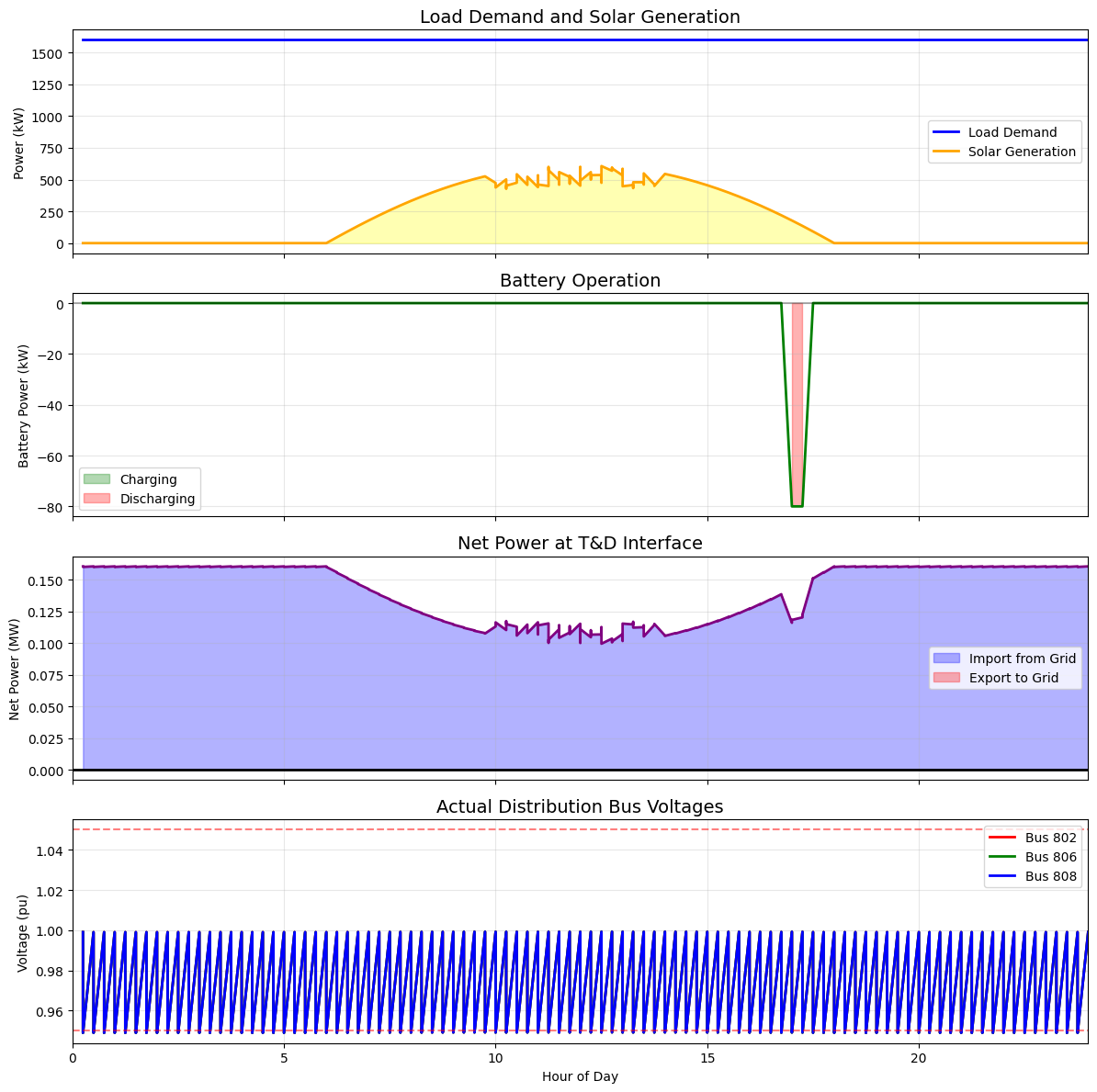
DER Impact Analysis Summary (from Co-simulation)
==================================================
Peak Load: 1600 kW
Peak Solar: 607 kW
Peak Net Export: -99 kW
Hours with Reverse Flow: 0.0 hours
Daily Solar Energy: 4508 kWh
Solar Penetration: 44%
Voltage Statistics:
Min Voltage: 0.949 pu
Max Voltage: 0.999 pu
Voltage Violations: 519 instances
Summary and Future Directions#
This lesson demonstrated how distributed energy resources fundamentally change power system operation and the critical role of co-simulation in analyzing these changes. Key takeaways include:
Technical Insights#
Bidirectional Power Flow: DERs can cause distribution systems to export power to transmission, requiring new protection and control strategies.
Voltage Regulation Challenges: High DER penetration can cause voltage rise during low load periods, potentially requiring curtailment or advanced inverter controls.
Coordination Opportunities: Battery storage can mitigate solar intermittency while providing multiple grid services including peak shaving and frequency regulation.
Co-simulation Value#
The integrated T&D co-simulation with DERs enables analyses impossible with traditional tools:
Capturing transmission system impacts of distributed generation
Evaluating distribution hosting capacity considering transmission constraints
Optimizing DER dispatch for system-wide benefits
Future Applications#
The framework developed here extends to many emerging grid challenges:
Electric vehicle integration and vehicle-to-grid services
Microgrid formation and islanding studies
Resilience analysis with DER black-start capabilities
Market integration for DER participation in wholesale markets
As power systems continue evolving toward distributed, renewable, and interactive grids, co-simulation becomes an essential tool for planning and operations. The skills you’ve developed in this module provide a foundation for addressing the complex challenges of tomorrow’s power systems.
